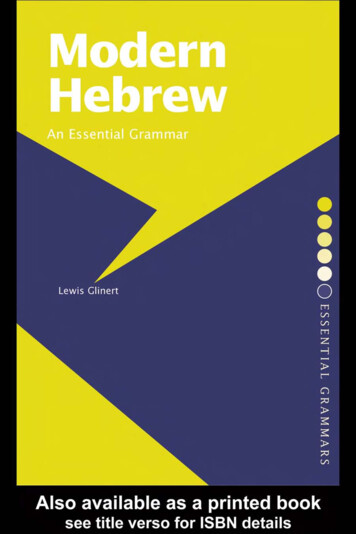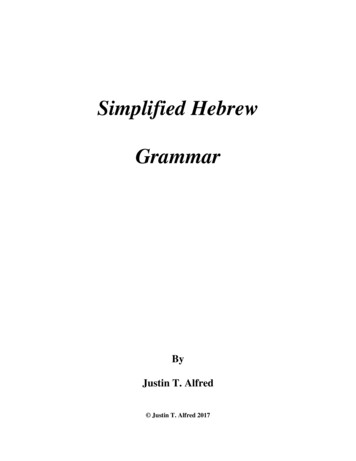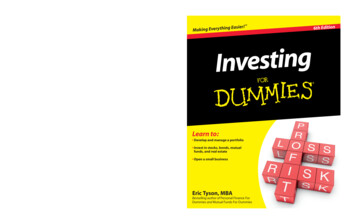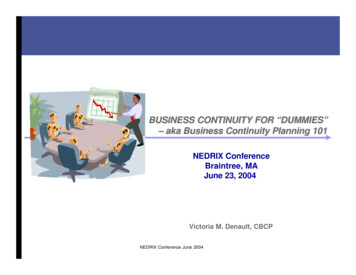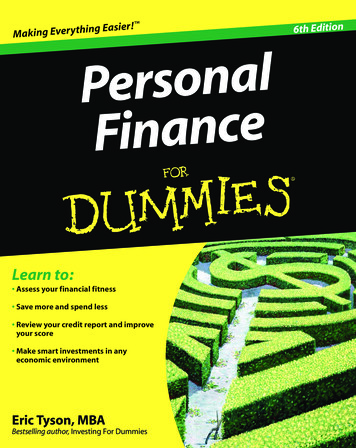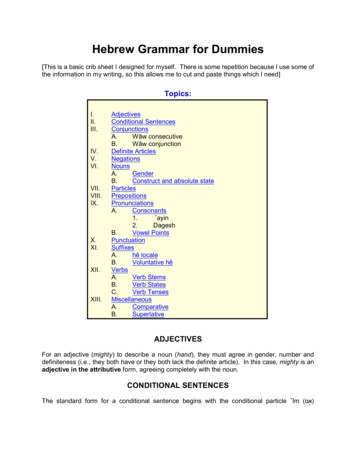
Transcription
Hebrew Grammar for Dummies[This is a basic crib sheet I designed for myself. There is some repetition because I use some ofthe information in my writing, so this allows me to cut and paste things which I XIII.AdjectivesConditional SentencesConjunctionsA.Wâw consecutiveB.Wâw conjunctionDefinite ArticlesNegationsNounsA.GenderB.Construct and absolute ts1.jayin2.DageshB.Vowel PointsPunctuationSuffixesA.hê localeB.Voluntative hêVerbsA.Verb StemsB.Verb StatesC.Verb TIVESFor an adjective (mighty) to describe a noun (hand), they must agree in gender, number anddefiniteness (i.e., they both have or they both lack the definite article). In this case, mighty is anadjective in the attributive form, agreeing completely with the noun.CONDITIONAL SENTENCESThe standard form for a conditional sentence begins with the conditional particle gîm (íàò)
[pronounced eem], which means if.1 Strong's #518 BDB #49. Generally speaking, the followingverb is an imperfect. There is no word in the Hebrew for then so a wâw consecutive is generallyused followed by a verb in the perfect tense. See 1Sam. 12:14 for more information.CONJUNCTIONSWhen we find the wâw consecutive linking a host of Qal imperfects, the sense is not a continuedaction in the verbs, but a continued, chronological, logical action of the action of the verbs. Thatis, there is a continued action, but it is all of the verbs together which give us a continued action,rather than the verbs taken individually (in fact, it was from constructions like this that the wâwconsecutive first was called a wâw conversative, which is an incorrect designation and nsDefinite ationsPunctuationSuffixesVerbsThe DEFINITE ARTICLEA noun in the construct state does not take on a definite article. The noun following it will have thedefinite article, which means, in the English translation, they will both have a definite article (or, theywill begin with a definite article). I don’t see proper nouns with definite articles very often; one ofthe exceptions is the adjective gentis Dan in Judges 18:11. Several exceptions in Judges 19:13.NEGATIONSA negative particle used with the perfect verb would indicate a state of action which has neveroccurred.1gal (ì à) [pronouncedal]not; nothing; noneadverb of negation;conjunction ofprohibiting,dehorting,deprecating, desirethat something notbe doneyârêg (àøé)ÅÈ[pronounced yawRAY]to fear, to fear-respect, toreverence, to have areverential respect2nd person femininesingular, QalimperfectStrong’s #408BDB #39.Strong’s #3372BDB #431Actually, it can be used as a dem onstrative (lo, behold), an interrogative (usually expecting a negativeresponse and often used with other particles and rhetorically), and as a conditional particle (if, though); anindication of a wish or desire (oh that, if only; this is a rare usage). The Hebrew does not distinguish theseas obviously as does the Arabic.
There are two primary negatives in the Hebrew and this verse may help us to distinguishbetween them. If we had used the other negative, lôg (àìÉ or à ì) [pronounced low]; this wouldread, you will not fear or you are not fearing. However, this is an order here, a command; Saulis profiting the woman from fearing. Therefore, this reads, do not fear or do not be afraid.NOUNSGender: The masculine gender of an adjective might refer to the moral or philosophicalramifications and the feminine gender might refer to the consequences of the word.Construct state: it is allowable to insert within a construct chain the hê directive, a preposition orthe suffixion of a pronoun.2Absolute StateConstruct iteration/TranslationGib ve jâh (äòÈ áxò )Ó[pronounced gib ve -ÌAW]GibeahGib ve jath (ú ò áxò )- Ó[pronounced gib ve - ìahth]Gibeath orGibeah of.battlemile chemeth (ú î ç ì îò) Ó[pronounced mil-khehmeth]battle of.mile châmâh (äîÈçÈ ì îò)Ó[pronounced mil-khawMAW]The —âh ending is changed to —ath; the —âh ending is changed to —ethThere are some nouns and verbs (when in the participle form) which exhibit no difference betweenthe absolute and the construct state (see various forms in Seow pp. 118–121)PARTICLESWhen we have two sentences, the first introduced by the disjunctive particle ha (äÇ ) [pronouncedhah] (Strong’s #none BDB #209) and the second by the hypothetical particle ’îm (í àò ) [pronouncedeem] (Strong’s #518 BDB #49), this is a disjunctive question. A disjunctive question may expressa real alternative or the same thought may be repeated in a different form as two parallel clauses.In the latter case, the answer no is expected. This is why many translations have the word or inthe second clause.2C. L. Seow, A Grammar for Biblical Hebrew; Abingdon Press, Nashville; 1995, p. 153.
AdjectivesConditionalSentencesConjunctionsDefinite ationsPunctuationSuffixesVerbsPREPOSITIONSSee Kelley pp. 68–71 for prepositions plus irregular suffixes.See Davidson for meanings.Lâmed with an infinitive connotes shall or must.PRONUNCIATIONSConsonants: The Hebrew letter ayin (ò ) probably had two distinct sounds as does thecorresponding Arabic letter. The harsher sound was probably close to a hard g sound, which waslost completely to later Hebrew pronunciation. The Septuagint in several places renders the ayinas a gamma when it transliterates such proper nouns as Zoar.3Let me mention something about the dagesh [pronounced DAW-geesh] found here and elsewhere.When found with the letters á , â , ã , ë , ô , ú , it sometimes has an affect on the pronunciation.There is not universal agreement on this, although this does affect the pronunciation in modernHebrew. This table might help:WithoutWithWithoutWithá bvv bë kh kâ gx gô f pã dy dú th tThis is called a dagesh lene [pronounced LEN-nee?]. These letters can be memorized with thewords BiG DucK FaT. We also have what is called a dagesh forte [pronounced four-TAY?]. Thisdoubles a consonant when used with any other consonant (it is never found with à , ä , ç , ò , orø ). The rules are as follows: (1) a dagesh found in any letter other than á , â , ã , ë , ô , ú is adagesh forte. (2) If a dagesh is found in one of those six letters and it is not preceded by a vowel,it is a dagesh lene. (3) When any of the six letters from BiG DucK FaT have a dagesh and arepreceded by a vowel, it is a dagesh forte.4 Here, because the vêyth is preceded by a silent sheva,it acts as a dagesh lene.Vowel Points: The vowel point Qâmêts is pronounced like the a in all. I perhaps overdo this,rendering it as aw. There is also the Short Qâmêts (which, to me, is indistinguishable fromQâmêts), which is pronounced o as in nor.3Zondervan Pictorial Encyclopedia of the Bible; 1976; Vol. 5, p. 1068.4Biblical Hebrew, an Introduction Grammar; Page H. Kelley; Eerdm ans Publishing; 1992; pp. 3, 12–13.
When a word is immediately followed by a Maqqêph (Ï ) [pronounced mak-KAYF], which looks likea hyphen and is not pronounced, it unites two words for the purpose of pronunciation. Thepronunciation is moved to the last syllable of the next word.PUNCTUATIONA pausal is a word denoted either by an gatnâh or a sillûg (as well as certain other strongdisjunctive accents). These are similar to vowel points which were added long after Scripture waswritten and they indicate that there is a break in speaking at this point. To us, that simply meansthe insertion of a comma or a semi-colon. Interestingly enough, this is one of the few marks ofpunctuation to be found in the Massoretic inite ationsPunctuationSuffixesVerbsSUFFIXESPerson Gender NumberHebrewPerson Gender NumberHebrew1st person singularé1st person plural{2nd person masculine singular 2nd person masculine pluralí ë2nd person feminine pluralï ë2nd person feminine singular3rd person masculine singular 3rd person masculine pluralí3rd person feminine singularä3rd person feminine pluralïIt’s actually a bit more complicated than that, as singular nouns and plural nouns have slightlydifferent endings, as do feminine and masculine nouns. However, this is simply a quickreference table.The hê locale: However, this word, after a verb of motion, has the locale âh [äÈ] ending. This iscalled the directive hê or the he locale, which often indicates direction and puts somewhat of anadverbial spin on the noun. Essentially, it answers the question where? The pronunciation of theword does not change. The directional hê indicates the direction in which something moves. It isoften used with the noun heaven and the most literal rendering in the English would beheavenward. We can also indicate the existence of the hê directional by supplying the prepositionsto or toward.The voluntative hê; that is, it ends with âh, not to indicate a feminine ending (although themeaning is similar), but this indicates that with the verb in the 1st person, we should have theadditional words let me, allow me to. The 1st person Niphal may require the additional word may,
might, ought, should. In the second person, we should have the additional word might; or, in anyperson we might add the word may, might. Surprisingly enough, I have found nothing concerningthe voluntative hê in any of my reference books (Gibson, Mansoor, Zodhiates or Kelley), but Owenpoints it out again and again, and the many translators of Scripture go along with this. Thisappears to be tacked onto imperatives to smooth them out and to recognize the volition of theperson being spoken to.The hê at the end is called a voluntative hê and the verb itself is known as a cohortative and isoften translated with the additional word let, may, might, ought, efinite ationsPunctuationSuffixesVerbsVERBSA finite verb in the Hebrew is a verb in the perfect, imperfect or imperative tense; this is becausethe verb has person and number (it is confined, you might say). However, infinite verbs, thosewhich are participles or infinitives, do not have person and number. Zodhiates says it can havegender and number.Verb Stems:The Hiphil is the causative stem, but it is often used to declare something is something. That is,the Qal stem might mean to twist; the Hiphil can mean to declare one as being twisted. SeeStrong’s #6140 BDB #786.The Hithpael is the reflexive of the Piel. The Hithpael conveys the idea that one puts himself intothe state or the action of the verb, which is an achieved state. Seow gives several uses: (1) Itsprimary use is reflexive—the verb describes action on or for oneself. That is, the subject of theverb is also the object of the verb. However, this does not completely convey the reflexive use,as there are examples where the verb takes on another object. These verbs are known astolerative—the subject allows an action to affect himself or herself. (2) Reciprocal use:Occasionally, the Hithpael denotes reciprocity; that is, they worked with one another, they lookedat one another. (3) The third use is known as iterative, which means that the Hithpael suggestsrepeated activity (he walked about, he walked to and fro, and turned back and forth). (4) The fourthuse is known as estimative: the verb indicates how one shows himself or regards himself, whetherin truth or by pretense (he pretended to be sick, they professed to be Jews).5 (5) This canoccasionally be understood to be more of a passive than a reflexive (Gen. 22:18, for instance).6It is intensive (and sometimes seen as an accomplished state) and it is something that one doesto oneself. A related form is the Hithpolel (not found in Zodhiates, Mansoor’s Biblical Hebrew,5Choon-Leong Seow, A Grammar for Biblical Hebrew (Revised Edition); Abingdon Press, Nashville; 1995, pp. 298–299.6See also The Complete W ord Study Old Testament; Dr. S. Zodhiates; 1994 AMG Publishers; p. 2275.
Wilson’s Old Testament Word Studies or in Davidson’s Introductory Hebrew Grammar Syntax, butin The New Englishman’s Hebrew Concordance and in Kelley’s Biblical Hebrew). The differenceis that the endings are different, but it apparently still means the same thing as the Hithpael. Thisalso appears to be equivalent to the Hithpalal, mentioned by Owen in 1Sam. 1:3.The Hithpael is the reflexive of the Piel, and appears to be equivalent to the Hithpolel and theHithpalal (which are both found in Owen, but not elsewhere) and to the Hithpalel (found inOwen and Gesenius, but not in Zodhiates or in the Englishman’s Concordance). The Hithpaelconveys the idea that one puts himself into the state or the action of the verb, which is anachieved state. Seow gives several uses: (1) Its primary use is reflexive—the verb describesaction on or for oneself. That is, the subject of the verb is also the object of the verb. However,this does not completely convey the reflexive use, as there are examples where the verb takeson another object. These verbs are known as tolerative—the subject allows an action to affecthimself or herself. (2) Reciprocal use: Occasionally, the Hithpael denotes reciprocity; that is,they worked with one another, they looked at one another. (3) The third use is known asiterative, which means that the Hithpael suggests repeated activity (he walked about, he walkedto and fro, and turned back and forth). (4) The fourth use is known as estimative: the verbindicates how one shows himself or regards himself, whether in truth or by pretense (hepretended to be sick, they professed to be Jews).7 (5) The Hithpael can also be used in apassive rather than in a reflexive sense (see Gen. 22:18).8 The Hithpael is intensive (andsometimes seen as an accomplished state) and i
Hebrew Grammar for Dummies [This is a basic crib sheet I designed for myself. There is some repetition because I use some of the information in my writing, so this allows me to cut and paste things which I need] Topics: I. Adjectives II. Conditional Sentences III. Conjunctions A. Wâw consecutive B. Wâw conjunction IV. Definite Articles V. Negations VI. Nouns A. Gender B. Construct and .

